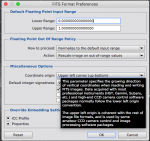run --execute-mode=auto "C:/Program Files/PixInsight/src/scripts/AdP/ImageSolver.js"
Processing script file: C:/Program Files/PixInsight/src/scripts/AdP/ImageSolver.js
* Using an automatically calculated limit magnitude of 17.15.
MultiscaleLinearTransform: Processing view: integration_working
Starlet transform: done
Multiscale reconstruction: done
Normalizing sample values: done
575.802 ms
Seed parameters for plate solving:
Image coordinates: RA = 13 14 46.000, Dec = +41 48 24.00
Resolution: 0.272 as/px
Starting StarAlignment iteration
Downloading Vizier data:
http://vizier.u-strasbg.fr/viz-bin/asu-tsv?-source=I/315/out&-c=198.691667 41.806667&-c.r=0.469649&-c.u=deg&-out.form=|&-out.max=200000&-out=3UC&-out=RAJ2000&-out=DEJ2000&-out=pmRA&-out=pmDE&-out=f.mag&-out=a.mag&-out=Jmag&-out=Hmag&-out=Kmag&-out=Bmag&-out=R2mag&-out=Imag&f.mag=<17.15
28574 bytes transferred in 0.94 s @ 29.78 KiB/s
FOV:0.470 actual:0.469
Catalog UCAC3 size: 238 objects
StarAlignment: Processing view: integration
integration:
Structure map: done
Detecting stars: done
45 stars found.
2.737 s
Using the polygon star matching algorithm with 5 sides.
StarAlignment: Processing view: integration
C:/Users/fred/AppData/Local/Temp/stars.csv:
Scanning star data: done
56 stars.
integration:
Structure map: done
Detecting stars: done
45 stars found.
Matching stars: done
21 putative star pair matches.
Performing RANSAC: done
* Previous attempt failed - this is try #2
useScaleDifferences=true
Matching stars: done
9 putative star pair matches.
Performing RANSAC: done
* Previous attempt failed - this is try #3
useScaleDifferences=false
* Reference image: Limiting to 30 brightest stars.
* Target image: Limiting to 30 brightest stars.
Matching stars: done
8 putative star pair matches.
Performing RANSAC: done
* Previous attempt failed - this is try #4
useScaleDifferences=true
* Reference image: Limiting to 30 brightest stars.
* Target image: Limiting to 30 brightest stars.
Matching stars: done
*** 0 star pair matches found - need at least six matched stars.
* Previous attempt failed - this is try #5
useScaleDifferences=false
* Reference image: Limiting to 15 brightest stars.
* Target image: Limiting to 15 brightest stars.
Matching stars: done
*** 0 star pair matches found - need at least six matched stars.
* Previous attempt failed - this is try #6
useScaleDifferences=true
* Reference image: Limiting to 15 brightest stars.
* Target image: Limiting to 15 brightest stars.
Matching stars: done
*** 0 star pair matches found - need at least six matched stars.
* Previous attempt failed - this is try #7
useScaleDifferences=false
* Reference image: Limiting to 8 brightest stars.
* Target image: Limiting to 8 brightest stars.
Matching stars: done
*** 0 star pair matches found - need at least six matched stars.
* Previous attempt failed - this is try #8
useScaleDifferences=true
* Reference image: Limiting to 8 brightest stars.
* Target image: Limiting to 8 brightest stars.
Matching stars: done
*** 0 star pair matches found - need at least six matched stars.
*** Error: Unable to find an initial set of putative star pair matches.
<* failed *>
*** Error: The image could not be aligned with the reference star field
Please check the following items:
- The initial coordinates should be inside the image.
- The initial resolution should be within a factor of 2 from the correct value.
- Adjust the star detection sensitivity parameter, so that the script can detect most of the stars in the image without mistaking noise for stars.
- The catalog should be matched to the image. Choose the appropriate catalog and magnitude filter, so that the number of stars extracted from the catalog can be similar to the number of stars detected in the image.
*** Error: Unable to plate solve image: Alignment failed
This usually happens because the initial parameters are too far from the actual metadata of the image.



